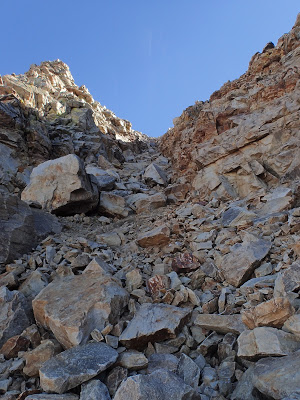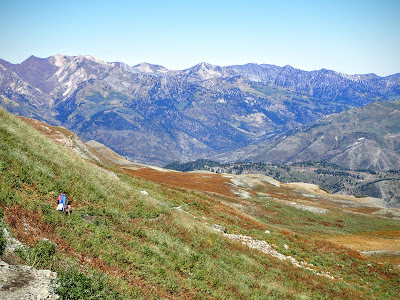 |
| Trying out the Asolos in the Intermountain West |
I would call these my "3.5 season boots". I say this because I can't really imagine getting cold in these boots and they're very compatible with microspikes/snow chains. However, they don't quite replace the need for mountaineering boots in trips with some degree of mixed mountaineering or any setting where crampons are needed.
Outstanding design for bad joints
I think that most of us have a joint that ends up being the great limiter in our outdoor adventures. For me, that joint has been my right ankle. There's a long history of moderate to severe right arch pain related to my trips involving longer distances. In baby videos of me learning to walk, I was already walking with my right foot turned out and with supination. Its the joint that is the first to get sore and the longest to heal.
What has made me such an enthusiastic fan of these boots is that after five days of
 |
| I ran up this class III scree at 11,000ft like it was a paved road |
When it came down to purchasing boots, I was going for something that would be a nice blend of a technical hiking boot but not quite a $500 dollar trekking boot. I wanted something I could take backpacking or for a longer day hike. This is particularly sensitive towards my proclivity to hike through poorly marked routes, not trails.
Now, when it comes to brands, I'm not married to one but I love my Lowa Mountaineering Boots and my Salomon Trail Runners. The Lowas are now 5 years old and have accompanied me on mountaineering trips from Rainier, Elbert, Hood, Adams, to winter ascents in the Presidentials of New Hampshire. I adore trail runners from Salomon; the've kept me warm and steady when I run on the icy, snow-ridden Chicago lakeshore trail. I started with these two brands for hiking boots.
I somewhat quickly discounted the Lowa Renegades; the angled design of the ankle collar didn't feel right with my ankle. As for the Vasques, I liked them in general but the lace-up design didn't fit my feet as well as the other two. The Vasque material overall seemed more durable but my feet began sweating in them after 5 minutes of walking around the store. They're great boots, but not for me.
The Asolos were the heaviest of the four, coming in at 3 lbs 2 oz compared to the Salomon Quest 4Ds which were 2 lbs 7 oz. It was a really tough decision at that point. I really loved the lightness of the Salomons which walked and almost felt like trail runners to me. But what really pushed me to go for the heavier Asolos was the lace up design; the boot contoured to my foot better than any of the others. This made all the difference out on the trail. I could hike 12 miles through the trail-less Ruby Mountains and wake up the next day to hike 14 miles through the Wasatch Mountains. My ankle felt no different despite buying a heavier boot.
 |
| Asolos passed my test! |
I've gone through several changes in thought processes during the last 10 years of serious hiking and backpacking. At one point I was just a broke college kid who wore through a pair of boots that were thousands of miles overdue for replacement. I suppose every college kid thinks this way but investing in good footwear ensure that you're still hiking on the same joints decades down the line.
At another point, I switched to either hiking in trail runners or mountaineering boots with nothing in between. This is also somewhat silly as, like everything outdoors, an experienced hiker will have a permutation of boots which can be adapted to many conditions. Now, most of us just don't have the resources to purchase 5 different boots. Call me a minimalist but I think there's three types of footwear that a real outdoorsman/outdoorswoman should have which will accommodate 95% of terrains and trips; Lightweight but sturdy trail runners, three-season backpacking boots and mountaineering boots. Hence, last summer I'm glad I invested in the second category.
I'm so impressed by the Asolos and given my complete lack of ankle pain that's plagued my hiking in the past, I'm sure I'll buy the same pair when these ones wear out. Glad I found my right match!
Read. Plan. Get Out There!





4 Comments
Hiking Camping
April 25, 2016 @ 12:25
Nice Post..An online camping and hiking supply store that provides free shipping to all of our products in online .
Hiking Storer
nancy
December 16, 2022 @ 05:53
I have bought a lot of hiking boots, Asolo fell apart without hardly using them..Left in the closet on the shelve and the sole disintegrated. really disintegrated. Like powder. I had boots for 30 years and never seen anything like. Very inferior product. Not happy. Keep to great name boots that last. I spent over $200 and worned only 14 days for a big hike.
Shane
February 13, 2023 @ 23:22
Nancy, the problem is hydrolysis. I’ve seen similar stories about other boots that use TPU mid soles. They simply cannot be left in conditions that are either too hot or humid without regular airing and use. When you wear the boots, the midsole compresses and expands which airs it out and extends the lifespan of the soles.
It is not a quality issue. It is not an issue of “great name boots that last”. It is a chemical process that is a side effect of the use of PU in the midsole. The issue affects companies such as Meindl and Lowa that have been producing boots for over a century. They use PU midsole in some boots because they give more sustained rebound over long hikes when actually worn. Asolo are making boots that perform over multi-day hikes and they frequently use a PU midsole for sustained rebound over many kilometers. Asolo are not idiots, their products are well made and they even have a section on their website explaining how to care for their boots to avoid the problems you experienced. The biggest problem here is retailers don’t warn customers of the need to care for a PU soled boot in a special way to avoid hydrolysis damage. And a big part of the fix is to simply wear the boots frequently throughout the year.
Hydrolysis in boots is mostly life’s way of telling you that you have bought a pair of hiking boots that are designed for someone else and you should have bought an EVA soled light hiker instead that could be left on the shelf. Alternatively, if you genuinely need a PU soled boot for some of the year you must wear it a bit throughout the year.
I regularly hike in mountainous land with boggy areas that could destroy my boots if I didn’t clean them and dry them properly. Since I learned about hydrolysis over 15 years ago I have not had a boot fail prematurely.
Rick
April 30, 2023 @ 11:38
HGreat post my friend, I am looking to buy a pair of boots for myself, my problem is that I have wide feet, what are those like for people with wide feet?….thanks for your time….Rick